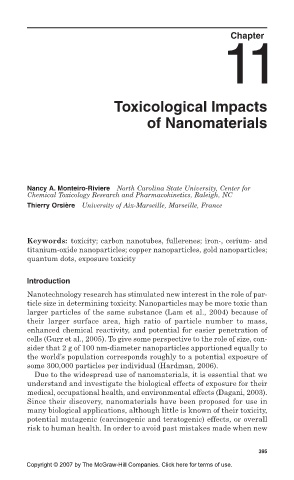Page 412 - Environmental Nanotechnology Applications and Impacts of Nanomaterials
P. 412
Chapter
11
Toxicological Impacts
of Nanomaterials
Nancy A. Monteiro-Riviere North Carolina State University, Center for
Chemical Toxicology Research and Pharmacokinetics, Raleigh, NC
Thierry Orsière University of Aix-Marseille, Marseille, France
Keywords: toxicity; carbon nanotubes, fullerenes; iron-, cerium- and
titanium-oxide nanoparticles; copper nanoparticles, gold nanoparticles;
quantum dots, exposure toxicity
Introduction
Nanotechnology research has stimulated new interest in the role of par-
ticle size in determining toxicity. Nanoparticles may be more toxic than
larger particles of the same substance (Lam et al., 2004) because of
their larger surface area, high ratio of particle number to mass,
enhanced chemical reactivity, and potential for easier penetration of
cells (Gurr et al., 2005). To give some perspective to the role of size, con-
sider that 2 g of 100 nm-diameter nanoparticles apportioned equally to
the world’s population corresponds roughly to a potential exposure of
some 300,000 particles per individual (Hardman, 2006).
Due to the widespread use of nanomaterials, it is essential that we
understand and investigate the biological effects of exposure for their
medical, occupational health, and environmental effects (Dagani, 2003).
Since their discovery, nanomaterials have been proposed for use in
many biological applications, although little is known of their toxicity,
potential mutagenic (carcinogenic and teratogenic) effects, or overall
risk to human health. In order to avoid past mistakes made when new
395
395
Copyright © 2007 by The McGraw-Hill Companies. Click here for terms of use.

